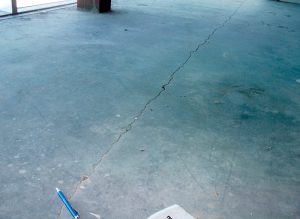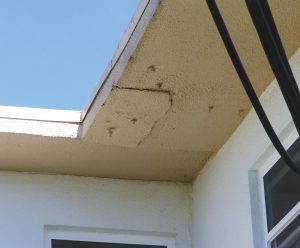A s structural engineers, we have many responsibilities. Our most important responsibility is to hold paramount the safety and health of the public; therefore, our primary focus is on designing sound structures with adequate strength and stability. Another responsibility that we have is to meet the owner’s expectations regarding the performance and durability of his or her structure.

For many years, structural engineers have addressed those two responsibilities by designing for two limit states: strength and serviceability. The American Society of Civil Engineers’ standard ASCE 7-16, Minimum Design Loads and Associated Criteria for Buildings and Other Structures, defines a limit state as “a condition beyond which a structure or member becomes unfit for service and is judged either to be no longer useful for its intended function (serviceability limit state) or to be unsafe (strength limit state).” The consequences for exceeding the two limit states differ significantly. For example, strength limit state failures range from design deficiencies to structural collapses; whereas, a serviceability issue may be no more than annoying floor vibrations. Nonetheless, serviceability issues may have severe economic consequences. As noted in the commentary of ASCE 7-16, some serviceability failures can lead to safety issues, such as cladding falling off of a building due to excessive movement of the structure. Therefore, the term “failure” should not just be limited to deficient strength and stability of the structure.

So what can structural engineers do to reduce their exposure to serviceability claims? Four suggestions to help with serviceability claims are briefly discussed below.
Understand Project Expectations
A serviceability failure typically means that the structure did not perform as intended or desired by the owner or the users of the structure and is typically a contractual matter. Consequently, the structural engineer must understand what the owner wants or expects and what the parties have agreed to provide. That means asking questions during the proposal and design phases and providing what some refer to as “expectation management.” Some issues that need to be addressed upfront regarding the owner’s or the client’s expectations include:
a) What is the intended use of the structure? This is an important issue for designing for strength and safety and designing for service issues, such as control of deflections and vibrations.
b) Does the owner need flexibility for future uses, such as a change of occupancy or to increase the potential lifespan of the structure?
c) Are the owner’s and architect’s expectations regarding fees, design and construction schedules, and construction costs reasonable? If a tight budget or short schedule may affect your ability to meet the project expectations, it may be best to walk away from such a project before getting started.
d) What is the scope of engineering services and the quality of work to be contracted? Be careful about providing warranties or guarantees for engineering services. Short of contractual agreements to the contrary, engineering services are held to the accepted standard of care, which is the care that structural engineers ordinarily provide under similar circumstances, not perfection.
e) If the owner or architect does not want to contract construction phase services, such as answering RFIs, shop drawing review, and site observations, are they aware of the importance of those services? Those tasks help to confirm that the contractor understands the work as well as provide a last opportunity to correct any design issues that may become evident.
f) Barring code-required inspection criteria, the structural engineer typically has no legal duty to inspect the construction unless contracted to do so. Therefore, the engineer may need to explain to the owner or architect the benefits of site observations. For example, periodic site visits by the engineer can head off problems before they happen. Site observations cost the owner a little more money upfront, but more often than not pay for themselves in the long run with higher quality construction.
g) Agree upon your role and do not take on responsibilities that are not yours. Construction projects involve many parties with differing skills and responsibilities. The contractor is responsible for the “means and methods of construction;” therefore, structural engineers must avoid supervising or controlling the contractor’s work. Design professionals are responsible for their design, approval of modifications to their design, and the acceptability of substitutions. For successful projects, design professionals must work with contractors and understand the difference between prudent assistance and control of the work. When it comes to serviceability issues, it may be better to define the final result desired rather than precisely specifying how specialty engineers, testing companies, and contractors can achieve that result.
h) Some serviceability issues may not immediately present themselves; therefore, documenting discussions and decisions made may prove to be very helpful in mitigating disputes which arise years after completion of the project.
Structural Movements and Vibrations
For serviceability design, the most important question regarding structural movement is: “What are the deflection, drift, and expansion/contraction requirements for non-structural items?” Given that a number of issues may result from structural movements, the structural engineer needs to determine acceptable deflection and drift limits to minimize damage to non-structural items on the project. At a minimum, the building code deflection and drift requirements need to be met. Other acceptable movement criteria may be obtained from the manufacturer or engineer of non-structural items, or reference documents such as those provided by the American Concrete Institute (ACI), the American Institute of Steel Construction (AISC), and the American Society of Civil Engineers (ASCE).
The appropriate service loads need to be used in drift calculations and the nature of the damage due to drift needs to be considered, or the design can become overly conservative for wind loads. For example, for Occupancy Category II buildings or structures defined in ASCE 7-16, strength design is based upon a mean return interval (MRI) of 700 years for the wind event. Drift calculations should be performed using a wind speed from one of the 10-, 25-, 50-, or 100-year MRI maps provided in the commentary, Appendix CC, of ASCE 7-16. Similarly, deflection calculations due to wind are typically based upon 0.42 (0.6 ASD wind load factor x 0.7 pressure reduction factor) times the component and cladding wind pressures, which corresponds to a 10 year MRI.
Building code deflection requirements to prevent damage to non-structural items, such as partitions and floor tile, due to gravity loads are typically based on span-to-deflection ratios. Those ratios are based upon dead and live loads applied after installing the item in question with consideration of creep due to sustained loads. For brittle materials, consideration should be given to limiting the maximum allowable movement regardless of the span of the element, the story height, or the building height. For example, some sources indicate that deflections for some masonry shall be limited to the lesser of the span/600 or 0.3 inches.
Modern “electronic” offices are problematic when it comes to floor vibrations. They commonly have long floor spans with few permanent partitions or heavy paper filing systems to dampen vibrations. The addition of fitness areas further exacerbates this situation. One complication in resolving vibration issues is that sensitivity to vibrations is highly subjective. The vibrations may be mildly annoying to one occupant, while to another occupant, the vibrations can be quite distressing. Therefore, like all other serviceability issues, it is best to address vibration control during the design phase.
Consider Durability and Maintenance
How does the owner feel about initial costs versus future maintenance costs? Investors may not be greatly concerned about long term maintenance. In contrast, the end-users typically are more concerned because they will have to deal with the maintenance and the associated possible loss of use of the structure. In the typical scenario where the owner contracts with the architect and the architect subcontracts a structural engineer, it is very helpful if the architect provides a “responsibility to maintain” clause in their contract with the owner. Such clauses put the owner on notice that the structure cannot be neglected for years and then claim faulty construction or design defects when, in fact, a failure to maintain the structure properly was the reason for the damage.
How is the structure going to be waterproofed? It is the author’s experience in Florida that water intrusion is the most common serviceability issue. Avoiding design details that tend to trap water and providing sufficient positive drainage go a long way to preventing water intrusion damage. Water intrusion can lead to serviceability issues (i.e., damage to non-structural items) and strength issues (i.e., deterioration of structural elements).
What is the exposure environment of the structure? Use industry-standard guidelines, such as ACI’s exposure classifications and the American Wood Protection Association’s (AWPA) Use Category System, which provide durability recommendations for various environments. ASCE 7-16 and AISC 360-16, Specification for Structural Steel Buildings, also provides recommendations for addressing durability issues.
The Standard of Care
All designs and construction are required to meet the code minimum requirements, but is that enough? Building codes primarily address minimum strength requirements and, to a much lesser degree, serviceability requirements. For example, Section 1.3.2 of ASCE 7-16 states:
Structural systems, and members thereof, shall be designed under service loads to have adequate stiffness to limit deflections, lateral drift, vibration, or any other deformations that adversely affect the intended use and performance of buildings and other structures based on requirements set forth in the applicable codes and standards, or as specified in the project design criteria. (Bold text added for emphasis)
The terms “adequate” and “adversely” make serviceability design subject to a fair degree of engineering judgment and differing opinions. Such gray areas, coupled with an evolving standard of care, increase the susceptibility of serviceability issues for litigation. Following the serviceability recommendations of recognized industry standards, along with knowledge and experience as to how structures behave, can go a long way towards meeting the standard of care for serviceability issues.
The most important task for structural engineers is to prevent a failure due to exceeding a strength limit state. However, structural engineers must also be aware that claims and economic consequences can also result from exceeding a serviceability limit state. Understanding project expectations, addressing serviceability and durability in design, and meeting the standard of care for engineers can help the structural engineer reduce the chance of claims for serviceability issues.■
References
ASCE (American Society of Civil Engineers). 2017. Minimum Design Loads and Associated Criteria for Buildings and Other Structures. ASCE/SEI 7-16. Reston, VA: ASCE.
AISC (2016). Specification for Structural Steel Buildings. ANSI/AISC 360-16, American Institute of Steel Construction, Chicago, IL.
